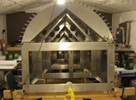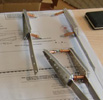


random user submitted photo
Flight testing - Vx & Vy
8 posts
• Page 1 of 1
Flight testing - Vx & Vy
Hey all,
In particular I have a question for Jeff Shultz - your spreadsheets for Vx/Vy are all up at 7000/7500 pressure altitude. Why that high? I would have thought to do it a couple thousand feet AGL, which puts me around 3000ish.
Anybody is welcome to add to the discussion. I'm trying to do some useful stuff during my flight test hours.
In particular I have a question for Jeff Shultz - your spreadsheets for Vx/Vy are all up at 7000/7500 pressure altitude. Why that high? I would have thought to do it a couple thousand feet AGL, which puts me around 3000ish.
Anybody is welcome to add to the discussion. I'm trying to do some useful stuff during my flight test hours.
Bryan Cotton
Poplar Grove, IL C77
Waiex 191 N191YX
Taildragger, Aerovee, acro ailerons
dual sticks with sport trainer controls
Prebuilt spars and machined angle kit
Year 2 flying and approaching 200 hours December 23
Poplar Grove, IL C77
Waiex 191 N191YX
Taildragger, Aerovee, acro ailerons
dual sticks with sport trainer controls
Prebuilt spars and machined angle kit
Year 2 flying and approaching 200 hours December 23
-

Bryan Cotton - Posts: 5489
- Joined: Mon Jul 01, 2013 9:54 pm
- Location: C77
Re: Flight testing - Vx & Vy
I would be trying to get sufficient test points to chart/graph from a "Standard Day at 0ft MSL" all the way till Vx and Vy meet in "coffin corner".
Graeme JW Smith
-

GraemeSmith - Posts: 939
- Joined: Sat May 18, 2019 8:58 am
- Location: RI
Re: Flight testing - Vx & Vy
Do Vx and Vy change with altitude? I would think not, since they are indicated airspeeds.
Maybe Jeff chose 7000' because that gives him longer at each point? Climb rates will be anemic way up there, so less stopwatch error.
Maybe Jeff chose 7000' because that gives him longer at each point? Climb rates will be anemic way up there, so less stopwatch error.
Bryan Cotton
Poplar Grove, IL C77
Waiex 191 N191YX
Taildragger, Aerovee, acro ailerons
dual sticks with sport trainer controls
Prebuilt spars and machined angle kit
Year 2 flying and approaching 200 hours December 23
Poplar Grove, IL C77
Waiex 191 N191YX
Taildragger, Aerovee, acro ailerons
dual sticks with sport trainer controls
Prebuilt spars and machined angle kit
Year 2 flying and approaching 200 hours December 23
-

Bryan Cotton - Posts: 5489
- Joined: Mon Jul 01, 2013 9:54 pm
- Location: C77
Re: Flight testing - Vx & Vy
Bryan,
They meet at "Coffin Corner" which is also the absolute altitude of the plane. At that point Vx and Vy are the same, you are at maximum engine power and also on the edge of a stall. Primer on Vx and Vy here:
https://www.boldmethod.com/learn-to-fly ... they-meet/
They meet at "Coffin Corner" which is also the absolute altitude of the plane. At that point Vx and Vy are the same, you are at maximum engine power and also on the edge of a stall. Primer on Vx and Vy here:
https://www.boldmethod.com/learn-to-fly ... they-meet/
Graeme JW Smith
-

GraemeSmith - Posts: 939
- Joined: Sat May 18, 2019 8:58 am
- Location: RI
Re: Flight testing - Vx & Vy
Right you are, Graeme. One of my flight test buddies from Sikorsky sez:
Vy goes down ~1% per 1000 ft (true speed goes up slightly). Vx goes up slightly and they are the same number at service ceiling (along with VH).
Bryan Cotton
Poplar Grove, IL C77
Waiex 191 N191YX
Taildragger, Aerovee, acro ailerons
dual sticks with sport trainer controls
Prebuilt spars and machined angle kit
Year 2 flying and approaching 200 hours December 23
Poplar Grove, IL C77
Waiex 191 N191YX
Taildragger, Aerovee, acro ailerons
dual sticks with sport trainer controls
Prebuilt spars and machined angle kit
Year 2 flying and approaching 200 hours December 23
-

Bryan Cotton - Posts: 5489
- Joined: Mon Jul 01, 2013 9:54 pm
- Location: C77
Re: Flight testing - Vx & Vy
Forgive my pedantry, but Graeme was correct when he said "absolute" ceiling. This is somewhat higher than "service ceiling". Absolute ceiling is probably one of those hypothetical places that you can only asymptotically approach in a stable atmosphere and my experience has always been that engine cooling really prevents me from flying the airspeeds necessary to fully explore those insane altitudes above ~12.5k where the service ceiling is. Maybe you'll have better luck with your RTV'd baffles.
Also, it intuitively makes sense that the two speeds should converge. Obviously, there's going to be some speed, Vy, where if you go any faster or slower at the absolute ceiling, you'll descend. By definition, then, this is also the speed of the steepest climb angle, Vx.
Graeme, I had to think about it for a while, but I don't think you will be on the edge of a stall at that speed. There is a "coffin corner" where stall and mach limit meet, but that's much higher than we can fly. Vx/y speeds are based on how much excess power or thrust the engine has over drag at a particular airspeed and angle of attack while stall is more purely based only on angle of attack.
As a thought experiment, consider simulating a low absolute ceiling of 3000ft by throttling back (limiting engine power) to where you can just barely maintain that altitude (on the front side of the power curve). Find a speed and power setting where if you speed up you'll descend and if you try to fly slower you'll descend (after an initial transient climb). You'll still have a long way to go to get an aerodynamic stall even though you end up descending when you slow down. Same thing up high--with our limited power, we can't reach the service ceiling while dragging the airplane through the air at that high of an angle of attack, so I'd expect there to be considerable margin above a stall. In fact, I'd expect us to be flying a bit higher than our normal Vy angle of attack from sea level, just in level flight rather than climbing.
Also, it intuitively makes sense that the two speeds should converge. Obviously, there's going to be some speed, Vy, where if you go any faster or slower at the absolute ceiling, you'll descend. By definition, then, this is also the speed of the steepest climb angle, Vx.
Graeme, I had to think about it for a while, but I don't think you will be on the edge of a stall at that speed. There is a "coffin corner" where stall and mach limit meet, but that's much higher than we can fly. Vx/y speeds are based on how much excess power or thrust the engine has over drag at a particular airspeed and angle of attack while stall is more purely based only on angle of attack.
As a thought experiment, consider simulating a low absolute ceiling of 3000ft by throttling back (limiting engine power) to where you can just barely maintain that altitude (on the front side of the power curve). Find a speed and power setting where if you speed up you'll descend and if you try to fly slower you'll descend (after an initial transient climb). You'll still have a long way to go to get an aerodynamic stall even though you end up descending when you slow down. Same thing up high--with our limited power, we can't reach the service ceiling while dragging the airplane through the air at that high of an angle of attack, so I'd expect there to be considerable margin above a stall. In fact, I'd expect us to be flying a bit higher than our normal Vy angle of attack from sea level, just in level flight rather than climbing.
- gammaxy
- Posts: 600
- Joined: Wed Sep 04, 2013 9:31 am
Re: Flight testing - Vx & Vy
Bryan Cotton wrote:Hey all,
In particular I have a question for Jeff Shultz - your spreadsheets for Vx/Vy are all up at 7000/7500 pressure altitude. Why that high? I would have thought to do it a couple thousand feet AGL, which puts me around 3000ish.
Not Jeff but he may have done those tests while he was based in Colorado at around 5,000 asl. He wouldn't have had the option of testing at a lower altitude while there.
Art,,,,,,,,,,,,,,,,,,,Sonex taildragger #95,,,,,,,,,,,,,,,,Jabiru 3300 #261
- builderflyer
- Posts: 441
- Joined: Sat Jul 09, 2016 12:13 pm
Re: Flight testing - Vx & Vy
gammaxy wrote:Absolute ceiling is probably one of those hypothetical places that you can only asymptotically approach in a stable atmosphere
Graeme, I had to think about it for a while, but I don't think you will be on the edge of a stall at that speed. There is a "coffin corner" where stall and mach limit meet, but that's much higher than we can fly. Vx/y speeds are based on how much excess power or thrust the engine has over drag at a particular airspeed and angle of attack while stall is more purely based only on angle of attack.
Need to go find my notes (buried somewhere). I had one of those "stable" days on a hard cold winter day where I had a 172, leaned for WOT, hanging on the prop, on the edge of a stall where Vx and Vy had met (there is a bit of an assumption that Vx and Vy had met!). Certainly, surprised the SWA 737 who I met coming the other way - up there! It had taken a lot of finessing to get there and his wake knocked me over from quite a ways a away and I spun down for a bit before I got enough bite of air on the rudder to recover.
Graeme JW Smith
-

GraemeSmith - Posts: 939
- Joined: Sat May 18, 2019 8:58 am
- Location: RI
8 posts
• Page 1 of 1
Who is online
Users browsing this forum: No registered users and 48 guests







